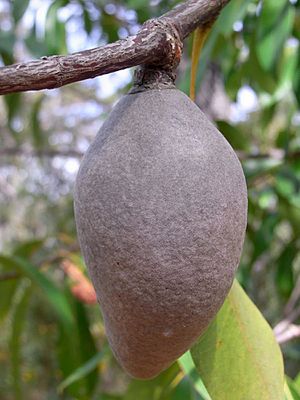Woody pear facts for kids
Quick facts for kids Woody pear |
|
|---|---|
 |
|
| Woody pear at Muogamarra Nature Reserve, Australia | |
| Scientific classification | |
| Genus: |
Xylomelum
|
| Species: |
pyriforme
|
The Xylomelum pyriforme, often called the woody pear, is a plant that belongs to the Proteaceae family. It grows naturally in eastern Australia. This plant can be a large shrub or a small tree, usually growing up to five metres tall.
Contents
What is the Woody Pear?
The woody pear is a unique plant known for its hard, pear-shaped seed pods. It's a native Australian plant that can survive tough conditions, including bushfires.
How the Woody Pear Got Its Name
The woody pear was first noticed by explorers Joseph Banks and Daniel Solander in 1770 at Botany Bay. A German botanist named Joseph Gaertner first described it in 1788. He called it Banksia pyriformis.
Later, in 1809, a gardener named Joseph Knight gave it its current scientific name, Xylomelum pyriforme. The word "pyriforme" comes from Latin words meaning "pear-shaped," which perfectly describes its fruit.
What the Woody Pear Looks Like
The woody pear usually grows as a large shrub or a small tree. It can reach about 4 to 5 metres (13 to 16 feet) tall. Some taller trees have been found, reaching up to 15 metres (49 feet).
Its leaves change as the plant grows. Young leaves have jagged or "toothed" edges. Older leaves have smooth edges. The leaves are dark green and smooth, measuring about 10 to 20 centimetres (4 to 8 inches) long. New growth on the plant often has a fine, rusty-coloured fuzz.
The woody pear flowers from September to November, with the most flowers appearing in October. Its flowers grow in rusty-coloured clusters that are about 5 to 8 centimetres (2 to 3 inches) long. After flowering, large, woody, pear-shaped seed pods grow. These pods can be up to 9 centimetres (3.5 inches) long and 5 centimetres (2 inches) wide.
Where the Woody Pear Grows
You can find the woody pear in New South Wales, Australia. Its range stretches from the mid-north coast down to Mittagong. There's also one record of it growing near Cooma.
This plant prefers to grow on high ground like plateaus and ridges. It likes sandy soils that don't have many nutrients and drain water well. It often grows in open forests with Eucalyptus trees. Some trees it grows near include yellow bloodwood, red bloodwood, and various types of scribbly gum.
Life Cycle and Survival
The woody pear has special ways to survive, especially after bushfires. It can regrow from a special woody swelling underground called a lignotuber. It can also sprout new shoots from buds hidden under its bark, called epicormic buds. Sometimes, it can even grow new plants from its roots.
Like some other Australian plants, the woody pear needs fire to help its seeds open and spread. This is a natural way for the plant to reproduce and continue its life cycle in the Australian bush.
Uses of the Woody Pear
Early European settlers in Australia found a use for the woody pear's strong wood. They used it to make parts for gun stocks.
Images for kids
See also
 In Spanish: Xylomelum para niños
In Spanish: Xylomelum para niños





